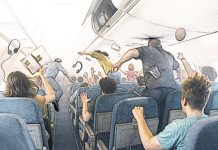It may be one of the more tedious aspects of flight planning but correct loading and centre of gravity of your aircraft is vital for safe flight.
With aircraft, as in life, a safe and comfortable journey often depends on a question of balance.
It was a question that would prove critical for the occupants of a Beechcraft Baron 95-B55 that left Sydney’s Bankstown Airport for Cooma one moonless evening in 1992.
The pilot and 5 passengers died when the twin-engine aircraft descended rapidly and ripped through trees on a ridge 700 metres above mean sea level, before bouncing about 20 metres and hitting a log, about 45 km north-east of Canberra.
The stage had already been set for an aviation tragedy when the aircraft took off on 19 June, overloaded and under the control of a 23-year-old pilot with just 3 hours’ experience on Beechcraft Baron series aircraft, in contravention of recency requirements.
Most of the pilot’s 920 hours of flying experience had been in small, single-engine aircraft. The pilot had recorded 60 hours in multi-engine aircraft, 32 of them in command, and had flown the Baron for less than an hour during a daylight proficiency check the day before the flight. The pilot’s logbook indicated the previous flight in a Baron had been 20 months before the accident.
While holding a command instrument rating for multi-engine aircraft and being a Grade 2 instructor, the pilot did not meet the recency requirements for either Instrument Flight Rules (IFR) or Night Visual Flight Rules (NVFR).
Nor was there any evidence the pilot had tried to meet these requirements, despite an awareness that at least part of the flight would be conducted at night.
The then Bureau of Air Safety Investigation (BASI) determined the aircraft was operating about 182 kg above the maximum take-off weight (MTOW) as it left Sydney, an issue investigators noted the pilot should have recognised.
‘The pilot had addressed various aspects of flight planning, including MTOW and CoG [centre of gravity] considerations, but his management of the actual aircraft loading did not reflect an appreciation of these aspects,’ the report said.
The flight departed at 1811 and tracked to the Shellys non-directional beacon before reporting to Canberra Approach Control and requesting clearance to enter controlled airspace at 1848.
He took off overloaded, the centre of gravity moved aft, so he was essentially a test pilot at night under instrument flight rules without the recency.
Five minutes after the pilot correctly acknowledged the clearance, air traffic controllers reported contact with the aircraft was lost.
It had been cruising at 8,000 feet when it entered a rapid descent and reversed direction, in a left turn.
The descent was briefly arrested at low altitude before the aeroplane again turned left and descended rapidly near Tarago in NSW.
BASI investigators calculated the aircraft was nose down and banked about 23 degrees to the right, as it hit the ground at an estimated speed of 150 to 180 knots.
Investigators suggested the aeroplane was loaded so its CoG was ‘most likely at or beyond the rear limit’ and there were indications it moved further aft during the flight.
It eventually reached a point where the pilot was unable to stop the aeroplane rapidly climbing and descending.
Their assessment was based on several factors, such as the flight profile recorded on radar as well as the need to place a considerable amount of baggage in the cabin and rear compartment because of limited storage at the front of the aeroplane.
Fluctuations in the rate of climb and descent, airspeed and altitude, were seen as non-responsiveness to control inputs and sensitivity to external disturbances – a condition consistent with a rear CoG position.
A factor in this, they said, could have been a rearward movement of the CoG due to a change in the distribution of fuel.
Using fuel from the main tank of a Baron can cause the CoG to move aft; an examination of the fuel selector valves showed each was selected to the main tank. The main tank was partially depleted but the auxiliary tanks were full.
‘The reason for the apparent deterioration in aircraft-handling characteristics during the flight could be the result of fuel burn-off from the main tanks, producing a rearward movement of the centre of gravity, and/or the movement during flight of baggage to a position further to the rear of the cabin,’ investigators said.
Ultimately, they added, the dark conditions and aircraft handling difficulty would have increased the workload to a significant level for a pilot with limited aircraft type experience and who had only flown daylight VFR in the previous 11 months.
A heavy lesson
CASA Aviation Safety Advisor Team Leader Michael White believes a pilot with recency in IFR and night VFR might have been attuned to the handling characteristics of the aircraft as the flight progressed.
He says the Baron would have been out of equilibrium, with the nose trying to pitch up, and the young pilot would have needed to keep correcting with downward pressure and re-trimming.
Even though the weather was clear, the moonless night meant the pilot would have been using the instruments to fly and, eventually, the aircraft moved outside its operating envelope.
‘He took off overloaded, the centre of gravity moved aft, so he was essentially a test pilot at night under instrument flight rules without the recency,’ White says.
‘So that probably didn’t help him recognise the symptoms as they were occurring until they got so bad, he had trouble controlling the aeroplane.’
White says pilots need to be at the top of their game when flying at night, even if the trip is progressing normally.
‘Night VFR and IFR conditions are particularly intolerant of error,’ he says.
A lack of understanding by the pilot of how fuel burn would affect the weight and balance of the aircraft was also a factor, although a change in the distribution of cabin baggage may also have contributed.
‘He was burning fuel from the main tanks so it’s quite likely, as he did that, the centre of gravity would move aft and it was already pretty much at the limit of the aft position on departure anyway,’ White says.
He notes some aircraft are more tolerant of shifts in the CoG than others and pilots may take the issue for granted when hopping from one aircraft to another.
As a rule of thumb, he says the CG should stay within limits, if pilots follow the manufacturer’s guidelines.
With some aircraft, such as the Beechcraft, the CG can move backwards as the flight progresses and, therefore, it is critical for pilots to do a CoG calculation at zero fuel weight.
‘You work out the centre of gravity’s position at zero fuel weight and then you work it out again at MTOW,’ he says. ‘If it’s within the limits on those 2 calculations, it will stay within those limits during flight as you burn fuel.’





